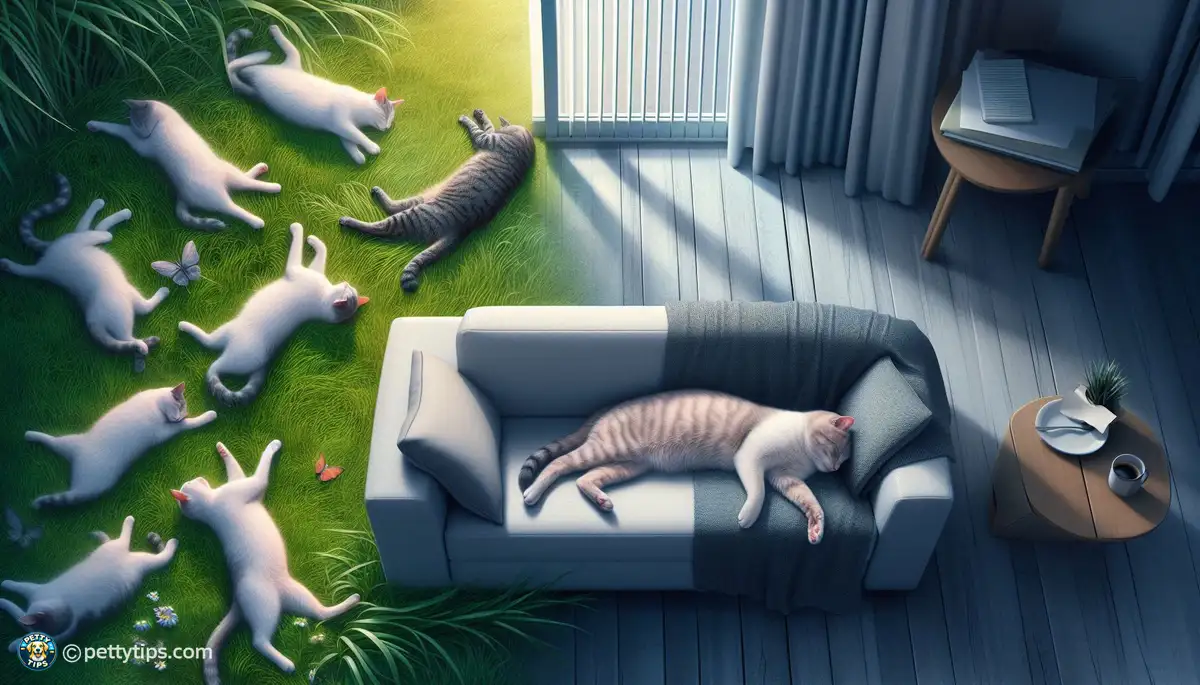
Effect of Catnip on Hunting Behavior
Earl Bolt - Sep 13, 2024 - 6 min read


Cats are renowned for their seemingly endless slumber. But have you ever wondered if indoor and outdoor cats sleep differently? Understanding the nature of cat sleep is crucial to deciphering this mystery. Cats are crepuscular creatures, meaning they are most active during dawn and dusk. However, their sleep patterns can vary based on factors like age, health, and environment.
Cat sleep is divided into two main phases: rapid eye movement (REM) sleep and non-rapid eye movement (NREM) sleep. During rem sleep, cats may twitch, vocalize, or even move their paws as if they're hunting. NREM sleep, on the other hand, is characterized by deep relaxation and bodily restoration. Both indoor and outdoor cats experience these sleep phases, but their environment can influence the duration and quality of their rest.
Indoor cats typically lead a more sedentary lifestyle compared to their outdoor counterparts. Without the stimuli of hunting and exploring, indoor cats may sleep longer and more frequently throughout the day. Additionally, indoor cats often adjust their sleep patterns to align with their human companions' schedules. This can lead to a more synchronized sleep-wake cycle between cat and owner.
Indoor cats also tend to seek out comfortable, safe spaces for sleep, such as cozy beds or sunny windowsills. These predictable environments can promote longer periods of uninterrupted sleep for indoor cats. However, indoor cats may face disturbances such as household noises or disruptions in their sleep environment, which can impact the quality of their rest.
Outdoor cats have a vastly different lifestyle compared to their indoor counterparts. With access to the great outdoors, these feline adventurers may engage in more physical activity, such as hunting, exploring, and patrolling their territory. As a result, outdoor cats may experience shorter, more fragmented sleep compared to indoor cats.
The outdoor environment presents both opportunities and challenges for cat sleep. While outdoor cats have the freedom to roam and indulge their natural instincts, they also face potential dangers such as predators, traffic, and inclement weather. Outdoor cats must remain vigilant even during sleep, as they must be prepared to defend themselves or flee from threats at a moment's notice.
Age plays a significant role in shaping cat sleep patterns. Kittens and senior cats tend to sleep more than adult cats. Kittens require ample rest for growth and development, while senior cats may experience changes in their sleep-wake cycle due to age-related conditions such as arthritis or cognitive decline.
A cat's health can directly impact its sleep patterns. Cats suffering from medical conditions or chronic pain may experience disturbances in their sleep. Similarly, stress, anxiety, or behavioral issues can disrupt a cat's ability to relax and sleep soundly. Monitoring your cat's sleep habits can provide valuable insights into its overall well-being.
The environment plays a crucial role in shaping cat sleep patterns. Indoor cats are exposed to different stimuli compared to outdoor cats. Factors such as temperature, lighting, and noise levels can influence a cat's ability to sleep comfortably. Creating a calm, soothing environment conducive to rest can help improve your cat's sleep quality, whether they're indoor or outdoor.
During REM sleep, cats may exhibit various behaviors, including twitching, whisker movements, and vocalizations. This phase is essential for cognitive function and emotional processing in cats. REM sleep is believed to play a role in memory consolidation and learning, making it a crucial aspect of feline sleep.
NREM sleep is characterized by deep relaxation and physical restoration. Cats spend a significant portion of their sleep cycle in NREM sleep, during which their body repairs tissues, regulates metabolism, and conserves energy. Providing a comfortable sleep environment can promote longer periods of NREM sleep for your feline companion.
Cats are naturally crepuscular animals, meaning they are most active during dawn and dusk. Understanding your cat's natural sleep-wake cycle can help you establish a routine that aligns with their needs. While indoor cats may adapt their sleep patterns to match their human companions' schedules, outdoor cats may follow a more flexible sleep-wake cycle influenced by environmental factors.
Provide your cat with a cozy, quiet space for sleep, away from household disturbances. Consider investing in a comfortable cat bed or perch where your feline friend can rest undisturbed.
Maintain a consistent feeding and play schedule to help regulate your cat's sleep-wake cycle. Engage in interactive play sessions during the day to encourage physical activity and mental stimulation.
Regular veterinary check-ups can help detect any underlying health issues that may be affecting your cat's sleep. Addressing medical concerns promptly can improve your cat's overall well-being and sleep quality.
In conclusion, while indoor and outdoor cats may have distinct sleep patterns influenced by their environment, age, and health, ensuring a comfortable sleep environment and addressing any underlying issues are key to promoting healthy sleep in cats. By understanding your cat's unique sleep needs and behaviors, you can help them enjoy restful slumber and live their best lives.